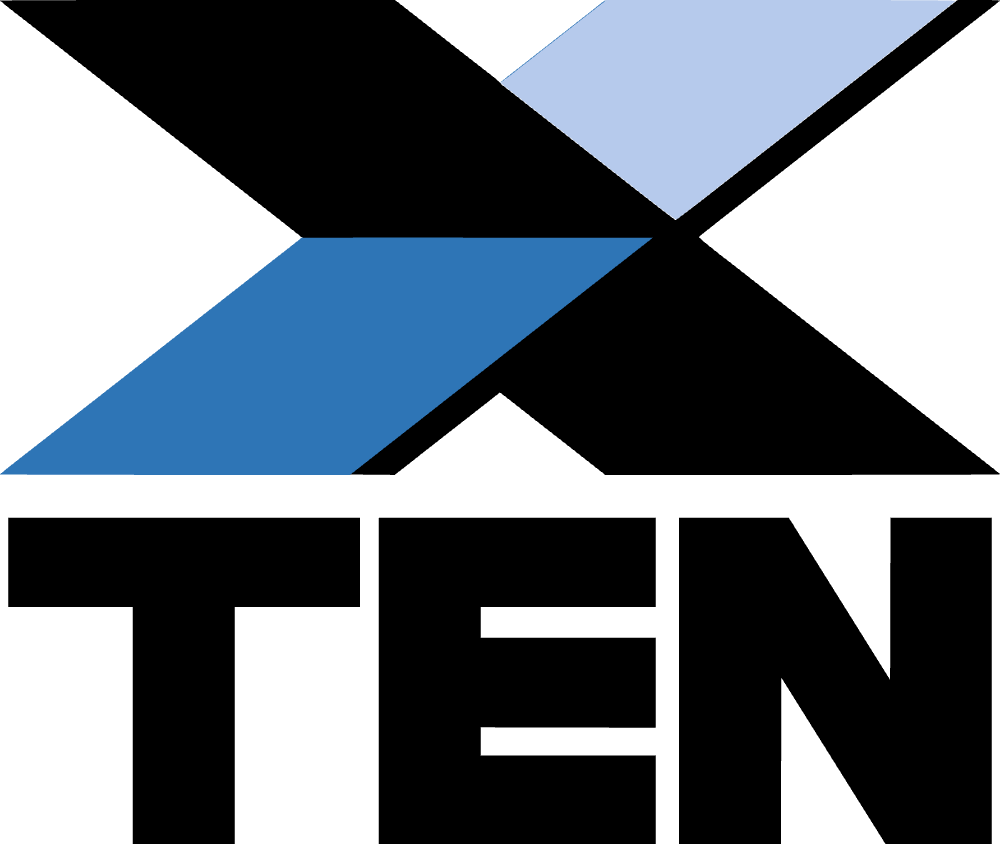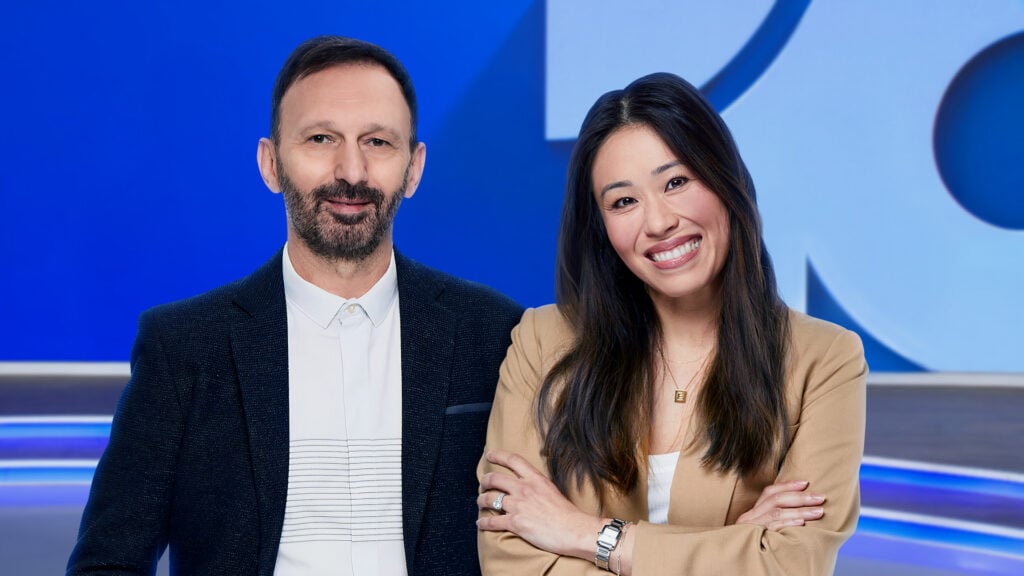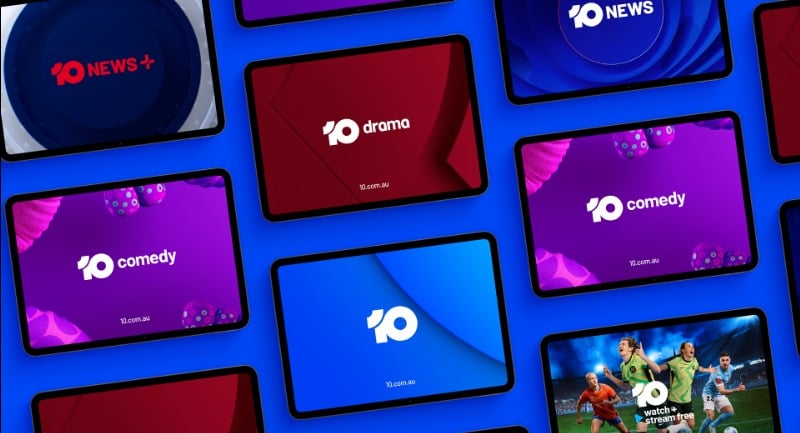In the dead of winter, Network 10 is getting in early with some spring cleaning. Recognising the shifting way we all engage with TV and talk about the TV channels we watch, from today, the network is consolidating its free-to-air, streaming, and programming channel names under one unified 10 brand.
Most of the changes feel obvious and are due for an update.
10 Bold Drama and 10 Peach Comedy, having each had a subtle name rebranding recently, reflecting their respective genre focus, will strip back their brand to the simplified ’10 Drama’ and ’10 Comedy’.
As 10 News First embarks on a new era starting today with the launch of a two-hour block of news from 5pm with the addition of the brand new 10 News+, it is simplifying the brand to ’10 News.’
But the real shift that will be difficult for media trade editors to build new muscle memory around, but will likely not be noticed by normal people, is the unified brand of the 10 primary channel and the streaming service. Gone is ’10play.com.au.’ Both will now just be known as ’10.’
Visitors to the 10play website will find that the website will redirect them to 10.com.au. Users accessing the 10 app via smart TVs and hand-held devices will see that the new branding will change when their apps next update. Viewers won’t notice it – they’ll just look for the 10 logo and open the app.
Most of 10s streaming viewing is done on connected TVs, with 86% of viewing done that way. Just 4% of viewing is on desktop computers where users are visiting it from the URL, with the remaining 10% of viewing is mobile and tablet.
Daniel Monaghan, SVP Content & Programming, Paramount Australia and New Zealand, said: “We are entering a new era as our brand evolves to more closely reflect the changing viewing habits of our audiences.
“With streaming now, a significant and growing component of total TV, unifying the 10 brand across all platforms ensures easier access to our premium content – anytime, anywhere, at no cost.”
The brand unification is accompanied by a refreshed visual identity for Network 10. The new logo suite will be rolled out across all platforms, including linear broadcast, digital streaming, marketing, communications, and social media.
There will also be an expansion of the FAST channels available on the 10 streaming service. From August there will be new channels: My Strange Addiction, Homicide Hunters, and Aftershock, plus shows from Working Dog (The Cheap Seats and Thank God You’re Here). Network 10 also announced a new British drama channel from All3Media: Demand Drama, which will include TV series’ adaptations from novels by esteemed English author, screenwriter and actress Lynda La Plante.
Mediaweek spoke with the architects of the rebranding project, Claudio Amati, Head of Network Creative, and Karen Song, Head of Network Design.
Mediaweek: Was there a scenario at all where you were thinking about taking the visual redesign in a very radically different direction?
Amati: Well, we rebranded in 2018. And that’s when we did radically move from the TEN to the 10 logo.
But at that stage, we always were looking at it as in future, like, where could it go?

Mediaweek: This is an evolution, not a revolution of the logo?
Song: Yeah, the foundations of that rebrand were really strong. So we just simplified it, made it more future proof, and streamlined it, made it digital first.
So the refresh that you saw there, it was designed to flex. We’ve learned a lot since 2018. And also, the markets have shifted quite a lot since 2018.
So what that brand needed to do in seven years ago is vastly different from now. And a lot of that came down to the streamlining of those sub-brands. So we simplified, streamlined that 10 experience.
So wherever you’re watching, it feels like 10. And that’s what audiences are doing already. So what we did, the design strategy and the creative strategy and the business strategy behind all of that is just meeting where the audiences are already.
Mediaweek: As we’re talking about evolution rather than revolution, there was no sort of danger of returning back to the X logo from the late 80s?
Amati: We did look at that back in 2018.

We were given a lot of different logo designs and we ended up actually designing our own in the end. We did look at the suite, but I think we landed on this because we felt it was really bold and it could stand.
Song: It’s digital first. It’s modern, simplified, works across all platforms. It’s able to flex and scale physically as well.
Amati: Also I needed it to work at the time with Bold and Peach. So it would have looked X Peach and X Bold. There were other considerations to take into account.
Mediaweek: X Peach is an appeal to a very different audience… So what were the inspirations in terms of what you’re looking at? Were there international campaigns and branding that you looked at that you kind of wanted to emulate?
Song: Well, the refresh this time around, it wasn’t a revolution. It was really an evolution. And really the core to the refresh was grounded in strategy.
So it was more of a strategic, not just a visual refresh. And that really set the foundation for how we approached flex. And we learned a lot in just the nature of the business and giving that tonal flex, that flexibility that we can balance content and brand and in a really cluttered landscape out there, creating that consistent brand awareness is core to what we’ve done here in this refresh.
So wherever you go, it feels like 10. Whatever you see, it feels like 10. And it’s just streamlining that experience. So, it’s easy to recognise and easy to love for our viewers. And it creates brand trust is what we were doing mainly in this refresh.
Mediaweek: Now, a rebranding like this doesn’t just happen in an afternoon…
Song: We did it all internally.
Mediaweek: So no third-party agencies at all?
Amati: No, we had a third-party agency just look at some of the strategies around where the business is sitting, but everything else was pretty much done in-house.
Song: We had a brand consultant. They weren’t even an agency, just a consultant and a copywriter to help us work through the playbook. But we did all the research and involved key stakeholders internally and developed the refresh internally.
We’re very much following global precedents for a lot of the brand unification that’s been seen in the UK, Four and Five have recently done it. So again, it’s the strategy that really anchored what we did in the refresh and the design system responded to that.
[Channel 4 and Five] They have a very similar market demographic to us. So it’s definitely a lot of those leading brands are streamlining their brand, they’re consolidating, they’re unifying and looking at those brands, not just as a broadcast brand, but a multi-platform brand.
Amati: It’s got such a big job to do now than what it did even seven years ago.
Song: Yeah. And future-proofing it basically, what the aspirations for the 10 brand and making, building in on that equity rather than diversifying that equity with all these sub-brands.
Mediaweek: Roughly, what sort of time period are we looking at here from the day where you called into the meeting and told you’re definitely doing it? I appreciate these are ongoing conversations.
Amati: So we kind of did a bit of a soft… I don’t know if you ever noticed it, but it was about, I’d say, 10 months ago we started on this.
We slightly rebranded 10 Peach to 10 Peach Comedy and 10 Bold to 10 Bold Drama because we knew this was happening and we just wanted to test the waters just to get people used to it. But I’d say it would be around 10 months we’ve been working on this.

Claudio Amati, Head of Network Creative and Karen Song, Head of Network Design
Mediaweek: Obviously, Ten’s a globally owned company. Was there much of an input from international colleagues or was it really just you guys more or less in a room?
Song: We had conversations with Channel 5 and lent into some of the research that they had done, which was really valuable because they had collaborated with an agency that gave huge insights. And a lot of, as I said, the demographic, there’s a lot of parallels. So they went with watch and stream.
So we built on that.
Amati: Based on the research that pretty much everybody is following at the moment with the streaming free message, I think everyone’s using the ‘Stream Free’ because there was research saying that consumers were a little bit confused as to whether these services were free or not. So because of all the subscription services as well, we decided to use ‘Watch and Stream Free’, just so that you know, this product is 10.
You can watch it for free on Linear, on Catch Up or BVOD, wherever you want. And then there’s Paramount Plus, which is the subscription. So it really kind of helps delineate that in the market.
Mediaweek: Is it a standard sort of font that you’re using for drama and comedy or is it a bespoke font?
Song: Barlow. Our house font. That’s a very considered approach that.. it’s not a star behind the comedy logo or some other shape between drama because Peach and Comedy already had those specific sub-brands.
What we wanted to do here is not have their genre-led approaches to the brand. They’re tilts or flavours to the main master brand. And that’s the strategy behind creating a master brand and creating that consistency and that streamlined approach that reduces confusion, streamlines the experience.
Amati: And it’s simple to see when you’re flicking through and you’re seeing like just a simple mark that tells you what’s on the box.
Song: We know that our modern viewers are choosing channels from a list of EPG, from an EPG or smart channel list. So these are simple frictionless ways in which they can quickly identify, immediately identify what they’re looking for. So that’s how our audiences are already interacting in the current landscape. So we’re just meeting them where they already are.
Mediaweek: Does the 10 streaming service just maintain the master brand?
Song: So that’s the key. That’s the other second part of our key simplification of our architecture was to amalgamate Ten and TenPlay.
Our audiences don’t delineate the difference between linear and streaming. So we didn’t need a brand that did that anymore. And we are first in the local market to unify those two brands together.
And as mentioned, that’s that global precedence that Five in the UK are already doing. And that’s just wherever they are, whether they’re streaming or they’re catching up or they’re watching live, it’s all the one 10 experience.
Mediaweek: What are you doing now that the project is done? Obviously, you’re not just putting your feet up until the next rebrand, but what does day-to-day work look like for you?
Song: Our day-to-day, I mean, our day-to-day and the design team specifically, we work across marketing, social, on-air promotions, sales, on the platform, as well as streaming.
Amati: We don’t just specifically look after the brand. We look after everything to do with marketing.
So all the billboards you see out, all the promos, that’s all made from this team that we head up. I look after the creative side of it and Karen looks after the design side of it, but it’s pretty much everything is done in here and we do all of it.
Mediaweek: How many assets do you think you’re probably dealing with on a weekly basis?
Amati: Hundreds.
Song: Thousands, actually. Thousands.
Amati: Thousands from your perspective, hundreds from ours. But with our recent campaign for the news, because it’s five states and different versions, we’re looking at hundreds and hundreds of promos that this team put through on a daily basis and that we’re across. So we’re across all of that. We’re across all the key art.
We’re across everything, the marketing, radio, everything.
Song: So we’re almost an internal agency in a lot of ways where we look at the concept and strategy from conception through to pre-production, through to pre-press or pre-flight, and then all the way to execution and rollout for all the different versioning aspect ratios, all of that.
So we look at it from end to end, from beginning to end.
Mediaweek: And is it just 10 assets or do you look after Paramount in Australia as well?
Yeah. So within our brand, we are involved, within our department, we look after Paramount as a global needs as well as 10.
Obviously, it’s the most demanding side of the business because we have to be reactive. And then also, I mean, streaming also takes quite a lot of our resources too. So we look after both sides of that.
